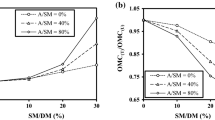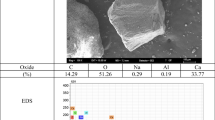Abstract
Fly ash microsphere (FAM) is a superfine fly ash product consisting of perfectly spherical and smooth particles. In this study, FAM was added to concrete for use in saline soil areas. The replacement levels of cement by FAM were 10% and 20% with a water-to-binder (w/b) ratio of 0.42. The hydration heat, thermogravimetric (TG) analysis, rheological performance, and the flowability of pure cement (CF0) and FAM-doped cement (CF10 and CF20) were investigated. The second exothermic peak occurred earlier and was higher in the FAM-doped cement than the CF0. The results showed that the nucleation effect of the FAM accelerated the early hydration speed of the cement. The TG results indicated that the Ca(OH)2 consumption was higher at 28 days due the addition of the FAM, which improved the interfacial transition zone and blocked the connected porosity of the hardened cement paste. The ball-bearing effect of the FAM particles in the paste reduced the internal friction between the grains, thereby significantly improving the rheology and the flowability of the cement paste. In addition, the filler effect of the FAM particles significantly improved the pore structure, which increased the compressive strength and chlorion penetration of the concrete. It was also found that the FAM increased the workability while improving the resistance of the concrete to sulfate attack when exposed to multiple drying–wetting cycles.







Similar content being viewed by others
References
Zhuang SY, Wang Q, Zhou YQ. Research on the resistance to saline soil erosion of high-volume mineral admixture steam-cured concrete. Constr Build Mater. 2019;202:1–10.
Pasupathy K, Berndt M, Sanjayan J, Rajeev P, Cheema DS. Durability of low-calcium fly ash based geopolymer concrete culvert in a saline environment. Cem Concr Res. 2017;100:297–310.
Neville A. The confused world of sulfate attack on concrete. Cem Concr Res. 2004;34:1275–96.
Chen F, Gao JM, Qi B, Shen DM, Li LY. Degradation progress of concrete subject to combined sulfate–chloride attack under drying–wetting cycles and flexural loading. Constr Build Mater. 2017;151:164–71.
Nie LX, Xu JY, Bai E. Dynamic stress–strain relationship of concrete subjected to chloride and sulfate attack. Constr Build Mater. 2018;165:232–40.
Wang DZ, Zhou XM, Fu B, Zhang LR. Chloride ion penetration resistance of concrete containing fly ash and silica fume against combined freezing–thawing and chloride attack. Constr Build Mater. 2018;169:740–7.
Shi MX, Wang Q, Zhou ZK. Comparison of the properties between high-volume fly ash concrete and high-volume steel slag concrete under temperature matching curing condition. Constr Build Mater. 2015;98:649–55.
Lorente S, Pierre M, Cubaynes Y, Auger J. Sulfate transfer through concrete: migration and diffusion results. Cem Concr Compos. 2011;33:735–41.
Ferraris CF, Stutzman PE, Snyder KA. Sulfate resistance of concrete: a new approach. R&D serial no. 2486. Skokie: Portland Cement Association; 2006.
Liu GJ, Zhang YS, Ni ZW, Huang R. Corrosion behavior of steel submitted to chloride and sulphate ions in simulated concrete pore solution. Constr Build Mater. 2016;115:1–5.
Abdelmseeh VA, Jofriet J, Hayward G. Sulphate and sulphide corrosion in livestock buildings, part I: concrete deterioration. Biosyst Eng. 2008;99:372–81.
Zhang ZQ, Wang Q, Chen HH, Zhou YQ. Influence of the initial moist curing time on the sulfate attack resistance of concretes with different binders. Constr Build Mater. 2017;144:541–51.
Wang Q, Wang DQ, Zhuang SY. The soundness of steel slag with different free CaO and MgO contents. Constr Build Mater. 2017;151:138–46.
Kwan AKH, Chen JJ. Adding fly ash microsphere to improve packing density, flowability and strength of cement paste. Powder Technol. 2013;234:19–25.
Collins F, Sanjayan JG. Effects of ultra-fine materials on workability and strength of concrete containing alkali-activated slag as the binder. Cem Concr Res. 1999;29:459–62.
Shaikh FUA, Supit SWM. Compressive strength and durability properties of high volume fly ash (HVFA) concretes containing ultrafine fly ash (UFFA). Constr Build Mater. 2015;82:192–205.
Chen JJ, Ng PL, Li LG, Kwan AKH. Production of high-performance concrete by addition of fly ash microsphere and condensed silica fume. Procedia Eng. 2017;172:165–71.
Wang Q, Wang DQ, Chen HH. The role of fly ash microsphere in the microstructure and macroscopic properties of high-strength concrete. Cem Concr Compos. 2017;83:125–37.
Laskar AI, Talukdar S. Rheological behavior of high performance concrete with mineral admixtures and their blending. Constr Build Mater. 2008;22:2345–54.
Sun W, Yan HD, Zhan BG. Analysis of mechanism on water-reducing effect of fine ground slag, high-calcium fly ash, and low-calcium fly ash. Cem Concr Res. 2003;33:1119–25.
Kwan AKH, Li Y. Effects of fly ash microsphere on rheology, adhesiveness and strength of mortar. Constr Build Mater. 2013;42:137–45.
Yang T, Zhua HJ, Zhang ZH, Gao X, Zhang CS, Wu QS. Effect of fly ash microsphere on the rheology and microstructure of alkali-activated fly ash/slag pastes. Cem Concr Res. 2018;109:198–207.
Provis JL, Duxson P, Deventer JSJV. The role of particle technology in developing sustainable construction materials. Adv Powder Technol. 2010;21:2–7.
Sun JF, Shen XD, Tan G, Tanner JTE. Compressive strength and hydration characteristics of high-volume fly ash concrete prepared from fly ash. J Therm Anal Calorim. 2019;136:565–80.
Escalante JI, Gomez LY, Johal KK, Mendoza G, Mancha H, Méndeza J. Reactivity of blast-furnace slag in Portland cement blends hydrated under different conditions. Cem Concr Res. 2001;31(10):1403–9.
Wczelik WN. Heat evolution in hydration cementitious systems admixture with fly ash. J Therm Anal Calorim. 2001;65:613–9.
Han FH, Zhang ZQ, Liu JH, Yan PY. Hydration kinetics of composite binder containing fly ash at different temperatures. J Therm Anal Calorim. 2016;124:1691–703.
Feng JJ, Liu SH, Wang ZG. Effects of ultrafine fly ash on the properties of high-strength concrete. J Therm Anal Calorim. 2015;121:1213–23.
Collepardi M. A state-of-the-art review on delayed ettringite attack on concrete. Cem Concr Compos. 2003;25:401–7.
Author information
Authors and Affiliations
Corresponding author
Additional information
Publisher's Note
Springer Nature remains neutral with regard to jurisdictional claims in published maps and institutional affiliations.
Rights and permissions
About this article
Cite this article
Wang, X., Yuan, J., Wei, P. et al. Effects of fly ash microspheres on sulfate erosion resistance and chlorion penetration resistance in concrete. J Therm Anal Calorim 139, 3395–3403 (2020). https://doi.org/10.1007/s10973-019-08705-8
Received:
Accepted:
Published:
Issue Date:
DOI: https://doi.org/10.1007/s10973-019-08705-8




